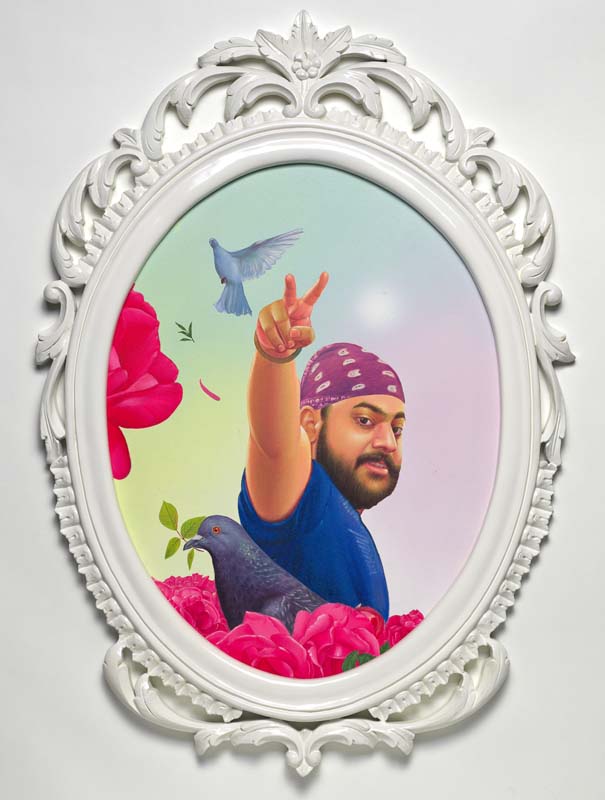We acknowledge the Traditional Owners of the land on which the Queensland Art Gallery | Gallery of Modern Art stands and recognise the creative contribution First Australians make to the art and culture of this country.

Thukral & Tagra / India est. 2000 / morpheus (two pigeons); morpheus (pigeon); morpheus (I love new york) 2009 / Synthetic polymer paint and oil on canvas / Three paintings: 97 x 52cm (framed); 94 x 65cm (framed); 84 x 58cm (framed) / The Kenneth and Yasuko Myer Collection of Contemporary Asian Art. Purchased 2010 with funds from Michael Sidney Myer through the Queensland Art Gallery Foundation / Collection: Queensland Art Gallery | Gallery of Modern Art / © Jiten Thukral and Sumir Tagra
THUKRAL & TAGRAmorpheus (two pigeons); morpheus (pigeon); morpheus (I love new york) 2009
On Display: Regional Touring Exhibition
Much of Thukral & Tagra’s practice is inspired by a particular aspect of Punjabi society in which young people, particularly men, are encouraged to move abroad. While wandering and migration are longstanding in Punjabi culture, emigration accelerated during the second half of the twentieth century, through increased global demand for labour and more relaxed immigration policies, particularly in the West. Local ‘push factors’, including growing modernisation and the decline of the rural economy have contributed to this trend,1 along with persistent cultural forces, such as the high status bestowed on those who migrate and, by extension, on their families at home.
Both of Punjabi background, Thukral and Tagra began to document and analyse this situation, linking it to broader shifts in Indian society. Drawing on personal experience, interviews with young men, as well as their observations of rampant urban development and consumption throughout India, the artists have constructed a hallucinatory image world of hyped-up aspirations and burgeoning wealth. Glossy paintings, fashionable clothing and shelves bursting with packaging fill their installations, which are often configured as retail or domestic environments.
The three portraits morpheus (two pigeons), morpheus (pigeon) and morpheus (I love new york) are part of installation of a large living room. The subjects are young men who have left home to pursue a supposedly better life overseas.
Endnotes:
1 Gurharpal Singh and Darshan Singh Tatla. ‘Sikhs in Britain: The Making of a Community’, Zed Books, London, 2006, pp.26–42.
Jiten Thukral (b.1976) and Sumir Tagra (b.1979) – aka Thukral & Tagra – offer a seductive and vibrant take on contemporary Indian society and culture. Witty and colourful, Thukral & Tagra’s refined aesthetic is applied to painting, sculpture and installation, as well as graphics, interiors, fashion and product design, often under the label Bosedk, blurring the boundaries between advertising, branding, retail and art.
Their structured approach gives their projects a high level of detail, finish and accessibility, with themes researched and developed over time, and made adaptable to specific concerns and contexts. Coming from a generation of Indian artists for whom ‘transcultural experience is the only certain basis for contemporary artistic practice’,1 Thukral & Tagra’s work ranges freely across many forms and references, while maintaining a distinctly local perspective.
Endnotes:
1 Ranjit Hoskote, ‘Signposting the Indian Highway’, in Indian Highway [exhibition catalogue], Serpentine Gallery/Koenig Books, London, 2009, p.193.